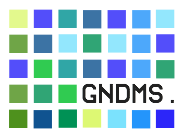The GORFX-Rest Service
Note: this section is only for developers which are interested in the progress of the REST port of GNDMS.
The branch rest-mock contains ad-hoc implementation of the GORFX rest specification. It can be used by developers of GNDMS client services to test the integration and the basic setup.
The interface is stable with the exception that new methods might be added and some types may be refined.
The branch has three imported folders:
- gndmc-rest Contains the code of the client side.
- gorfx Holds the restified GORFX service code.
- gndms-commons Contains code shared by the client and service, e.g. types used for exchange and the interfaces describing the service.
Some Terms
Taskflow Taskflows are complex tasks executed by the GORFX-Service. They are usually started by sending an order to the GORFX-Service, the service responds with a taskflow specifier. This specifier can by used by the client to negotiate the execution timing (quote) of the taskflows task (CoScheduling) and to trigger the task execution.
Order Request for a taskflow, contains necessary information for the taskflow, like the source and destination of a file transfer.
Quote Constrains for taskflow execution, like memory usage or processing time. This is usually computed by an quote-calculator supplied with a specific taskflow on the service side.
Task Is the execution unit of a taskflow. A task can be queried about the state of the execution, and provides results and errors. A task mustn’t necessarily belong to a taskflow. It can be triggered by an configuration change or a batch action.
batchAction A one-shot task execution, e.g. some maintains stuff.
The Modules:
The following section contains information about the modules in the rest-mock branch.
The GORFX service:
The service is divided in three sub services:
- GORFX – entry point for the communication with the service. Most important task: it creates taskflows.
- TaskFlowSerivce – Handles all requests concerning a concrete task.
- TaskServce – Handles the life-cycle of a task, i.e. provides status information as well as result and error details.
Each of these services implements an interface which is documented and can be found in:
de.zib.gndms.GORFX.serviceThe Clients:
For each of the above services there exists an extra client, which implements the service interface and uses Springs REST-template to exchange HTTP-Requests with the service.
Additionally to the client which are dedicated to their services, there exist an client which mimics the basic taskflow execution. This client is located in:
de.zib.gndms.gndmc.gorfx.AbstractTaskFlowExecClientAn implementation of AbstractTaskFlowExecClient is also provided:
ExampleTaskFlowExecClientThis example implementation executes a dummy taskflow and writes lots of information to stdout. It is called by GORFXTaskFlowExample which executes a task which should run successfully and one which fails (intentionally).
The Dummy Taskflow:
The dummy taskflow does nothing spectacular, it writes a given message a number of times with a given delay between single writes. If requested it can throw an exception.
The result of the task is the complete written text.
Setup and Running:
Apart from Java 1.6 a jetty installation is required. I used jetty6 for testing.
Export the environment variable $JETTY_HOME pointing to the root directory of your jetty installation.
Export $GNDMS_SOURCE pointing to the source.
Add $GNDMS_SOURCE/bin to your PATH variable.
Call gndms-buildr deploy-rest
This should compile everything and copy the gndms.war to your $JETTY_HOME/webapps.
Set the environment variable GORFX_URL to
http://<yourhost>:<and-port>/gndms/<grid-name>Echo this to your grofx.properties
echo gorfxBaseURL=$GORFX_URL > $JETTY_HOME/resources/gorfx.propertiesStart Jetty
Running the Client
NOTE Running the client requires the GORFX_URL environment variable. Additionally an env-var GNDMS_DN must be set, with your grid DN.
To compile and run the client simply enter:
gndms-buildr gndms:gndmc-rest:runReusing Client Code
A client application will need the gndmc-rest.jar and the gndms-commons.jar. Plus the REST part of the Spring-framework and JodaTime. The best place to look for the complete dependency listing it the Buildfile that ships with the release.
Imported Types
The following lists some types defined in gndms-commons which are might be important to client-service developers. Additional documentation can be found here.
ResponseEntity
Each client call returns an instance of Springs ResponseEntity<T>. This entity has a HTTP Status which should be checked before the response body is used.
Specifier
Often the response entity contains a Specifier<T>. This specifier describes the target resource, it holds the URI of the resource, together with a map of the path variables (see. REST-Spec). Additionally the specifier can carry a payload, which is either the desired value in case of a GET request, or the result of a GET request on a newly created (with POST or PUT) resource.
Order
Base class for all taskflow orders. All orders for concrete taskflows will inherit from this class.
TaskStatus
This is the interface of task status objects. It has two important information: it shows if the task is running, finished or failed, and contains progress information which should be interesting for the user which started the task(flow).
GNDMSResponseHeader
This is mainly a wrapper around Springs HttpHeaders which offers methods to set GNDMS specific header files, like the DN or workflow Id.
